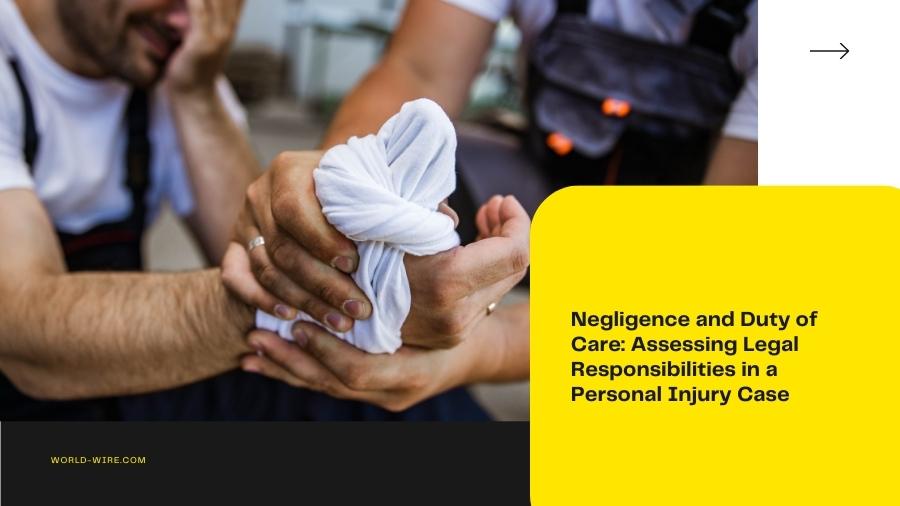Personal injuries can be a devastating experience, both physically and emotionally. They can result from various circumstances, such as car accidents, slips, and falls, medical malpractice, defective products, or unsafe conditions. While most personal injury cases arise after an accident due to negligence by another party, establishing legal responsibility is not always a straightforward process.
To win a personal injury lawsuit, the plaintiff (the injured person suing) must prove that the defendant’s (accused) acts caused their injuries through the following elements:
- Duty of care
- Breach of duty
- Causation
- Damages
This blog post will examine what constitutes a “duty of care” and explain how it impacts personal injury claims.
What Is “Duty of Care?”
The concept embodies an individual’s legal duty to exercise reasonable precautions against foreseeable harm to those potentially at risk. Essentially, it entails a responsibility to safeguard unintended parties from potential danger when conducting actions on owned or controlled properties. Instances encompass property proprietors upholding safety standards for visitors, doctors adhering to accepted protocols within their jurisdiction, and drivers complying with traffic laws.
This requisite level of care may fluctuate based on factors like age, usage circumstances, and the status of individuals as invitees or trespassers. Courts, however, consistently recognize the obligation to institute safety measures, prioritizing hazard prevention over personal convenience. If you or a loved one faces such situations, enlisting the support of a skilled law firm can be instrumental in securing maximum compensation. Their expertise can guide you through the legal intricacies, ensuring your rights are upheld and just compensation is pursued.
Breach of Duty
A breach occurs when any standard of care is negligently violated, resulting in reasonably unexpected damage directly attributable to that shortcoming. Before deciding, the court considers fault evidence such as diagnosis reports, interviews, procedure violations, and other authoritative sources.
Causation
To establish causation, the plaintiff must show that the defendant’s activity or inaction directly caused the plaintiff’s harm. This suggests that the injury would not have occurred if the defendant had not been negligent. When numerous variables contribute to an accident, responsibility may be shared among several individuals; nevertheless, more frequently than not, especially in non-medical incidents, the fault lies wholly with one party.
Damages
After responsibility is established, the plaintiff must present proof and evidence of damages (e.g., lost income, medical expenditures incurred due to the accident) to seek reimbursement from the defendants. Element assessments include pain and suffering, future medical bills, emotional discomfort, etc.
What Is The Legal Standard For Duty Of Care In Personal Injury Cases?
In personal injury cases, duty is determined by evaluating how a reasonable person would behave in similar circumstances. This evaluation considers the context and circumstances of the incident, as well as the responsibilities associated with actions taken on one’s property or building materials.
It also considers factors such as proper safety equipment, appropriate labeling of packaging, transportation, and storage practices, employing competent staff, recognizing limitations and strengths, and handling emergencies. Additionally, discretionary duties may be imposed when it is prudent to do so. In general, it is necessary to provide warnings regarding hazards and dangerous situations that already exist.
Ensure the work environment is safe and free from dangerous objects or materials. Additionally, it is important to properly maintain the roads and sidewalks to ensure the safety of pedestrians. It is also crucial to ensure that motorists obey traffic signals and signs.
The expected degree of exactness may vary significantly depending on the situation. Each case requires a unique analysis to determine which standards were violated and how they contributed to the harm suffered by the victim.
How To Prove Breach of Duty
To win at trial, it is necessary to show that the responsible individuals did not follow proper practices, protocols, and standards. They also failed to consider the potentially harmful outcomes and did not take sufficient care to avoid them. It is important to demonstrate that they must use appropriate methods and employ qualified practitioners. The focus should be on mitigating potential harm and addressing health, safety, and property risks.
Personal injury lawyers argue that defendants failed to meet the required standard of care when proving breach. They also argue that defendants were aware or should have been aware of any hazards in their conduct. These hazards resulted in injuries or accidents due to their lack of attention to prevention. The court will consider relevant evidence and other determining factors. These factors include authorized guidelines that outline one’s area of responsibility.
It is important to ensure these guidelines are correctly followed to maintain overall reasonableness and address any inherent dangers. Additionally, the court will consider data provided by industry experts regarding practices. The court’s ruling will be based on legal procedures established for resolving disputes and reaching a verdict.
Conclusion
Personal injury cases are often complex and technical. They involve various legal nuances requiring specialized experience and familiarity with documentation and regulation codes from different state regions to establish liability. Hiring an experienced attorney to handle these types of cases is crucial. They should be knowledgeable about the liabilities associated with the location in question and the common strategies used to defend and prosecute such lawsuits. This will ultimately assist in obtaining the best possible compensation to alleviate any unjust damages suffered, both presently and in the future.
Table of Contents







Add Comment